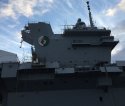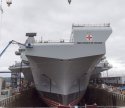Jura The idiot
General
Apr 21, 2018
Is Secretary of Defense Mattis planning radical changes to how the Navy deploys?
related:according to DefenseNews US weighs keeping carrier strike group in Europe as a check on Russia
Is Secretary of Defense Mattis planning radical changes to how the Navy deploys?
... size limit reached, goes on right belowA typical carrier deployment from Norfolk goes like this: A tearful goodbye on the pier, a trip across the Atlantic, then one or maybe two port visits in Europe before heading through “The Ditch” and into U.S. Central Command territory. There you will stay for the bulk of the cruise before returning the way you came.
Those days might be coming to an end.
The Navy and Pentagon planners the Truman Carrier Strike Group from deploying to U.S. Central Command, opting instead to hold the carrier in Europe as a check on Russia, breaking with more than 30 years of nearly continuous carrier presence in the Arabian Gulf. But even more fundamental changes could be in the works.
Defense Secretary Jim Mattis has made clear as the military’s top civilian that he has a very different vision for . And recent comments have hinted at big changes on the horizon for the Navy and how it deploys.
In testimony last month, Mattis twice compared that kind of predictability to running a commercial shipping operation, and said the Navy needed to get away from being so easily anticipated.
“That’s a great way to run a shipping line,” Mattis told the House Armed Services Committee. “It’s no way to run a Navy.”
But as Mattis and Chairman of the Joint Chiefs Gen. Joseph Dunford drive towards new ways of employing the fleet, changing the way that fleet deploys will put pressure on its existing deployment model, forcing the Navy to rethink a structure that governs nearly everything it does — from manning and training to its maintenance cycles.
In an era of great-power competition with China and Russia, Mattis describes the Navy showing up where it’s not expected, making deployments less burdensome to the fleet and its families but more worrisome to a potential adversary.
“The way you do this is [to] ensure that preparation for great power competition drives not simply a rotational schedule that allows me to tell you, three years from now, which aircraft carrier will be where in the world,” he told House lawmakers. “When we send them out, it may be for a shorter deployment. There will be three carriers in the South China Sea today, and then, two weeks from now, there’s only one there, and two of them are in the Indian Ocean.
“They’ll be home at the end of a 90-day deployment. They will not have spent eight months at sea, and we are going to have a force more ready to surge and deal with the high-end warfare as a result, without breaking the families, the maintenance cycles — we’ll actually enhance the training time.”
OFRP under pressure
Experts contend that what Mattis is describing, a concept he’s labeled as “Dynamic Force Employment,” would necessarily create tension with the Navy’s current deployment model known as the Optimized Fleet Response Plan, an iteration of similar plans that have been in place since the Cold War.
Under the plan, introduced in 2014 by then-Fleet Forces Commander Adm. Bill Gortney, ships operate in a 36-month cycle that carves out 16 months for training and maintenance, a seven-month deployment and 13 months where the carrier and its escorts are to maintain a high level of readiness in case it needs to deploy again.
Around that model the Navy builds everything from when it brings in new recruits to boot camp to when an aircraft carrier needs to come out of its years-long reactor overhaul. It’s also a system that builds in a significant dip in readiness where, during maintenance phases, ships lose sailors with critical skills to other commands and shore duty assignments.
The dip in readiness is deliberate and informs both manning levels on the ship and the Navy’s overall end strength. Simply put, there are not enough trained sailors in the Navy to fill every job on every ship, and that’s all built into the plan.
The key to the whole plan working, however, is at least a degree of predictability. Shipyards need to know when they will have a ship and what the scope of the repair work will be so it can prepare in advance. School houses need to know when to convene classes. Commanding officers need to know that when they get ready for deployment, sailors with critical skills lost during a readiness dip will be replaced before the next cruise.
Predictability, however, is precisely what Mattis is trying to have less of in the face of a rising threat from Russia and China, said Bryan McGrath, a retired destroyer skipper and consultant with The FerryBridge Group.
“[Optimized Fleet Response Plan] was designed to be predictable,” McGrath said. “From the outset it was touted for bringing predictability to the shipyards and to sailors and their families. Secretary Mattis, in the face of great power competition, seems to value those things less and I could not agree with him more.”
What Mattis seems to value is a system that would bank more readiness. Indeed, his National Defense Strategy says as much when it describes dynamic force employment.
“Dynamic Force Employment will prioritize maintaining the capacity and capabilities for major combat, while providing options for proactive and scalable employment of the Joint Force,” the strategy reads.
His suggestion of sending ships on more 90-day deployments would put less strain on ships’ mechanical and electronic systems and would likely make shipyard availabilities shorter.
But his example of putting three carriers in a place like the South China Sea, even for a couple of weeks, would eat an enormous amount of readiness under the current deployment model. Not only do you need to gather three fully manned and trained carriers with all their escort ships present, but three air wings full of tactical aircraft that have been struggling with their own readiness issues, as well.
“You can bank readiness by decreasing forward presence,” he said. “That is, if you have fewer forces forward deployed for the hell of it, you have more to push forward when you want them.
“In other words, its punishment rather than deterrence — you surge after the enemy has made its move. Whereas if you want to deter them — to convince the enemy that the success of their planned attack is dubious, you have to be there, and be there powerfully, and that means a carrier strike group forward.”
Another way to put three carriers forward in one place on a semi-regular basis is to use the sustainment period that is built into OFRP. But sending a carrier group back out during 13-month period after a deployment where the group is held at a high state of readiness undermines one of Mattis’s stated goals of trying to put less wear on the ships and ease the burden of eight-month deployments on families.
Double-pump deployments for surge carriers is precisely the kind of unpredictability and strain that has caused a mountain of maintenance problems for the Navy through the 2010s — problems that then reduce operational availability of ships that are stuck in the yards for repairs.
“The Navy has not done much with the sustainment phase in OFRP, but presumably that will be one of the go-to moves to create flexibility and unpredictability in the schedule,” McGrath said. “There will, of course, be costs: fuel costs, less time with families, etc.
“It remains to be seen the degree to which Mattis’ plans are doable within the current readiness model. My sense is the readiness model is somewhat brittle and additional requirements will put pressure on that model. The current OFRP was designed to create predictable, sustainable levels of readiness. SECDEF wants to be unpredictable. There is going to be tension.”
90-day deployments?
Another potential stumbling block for Mattis’ vision for a retooled deployment model is his desire for shorter deployments, specifically his 90-day deployment idea.
Clearly, shorter deployments would reduce the strain on the ships and its sailors and families. But at some point, basic geography would seem to get in the way of this idea, said Thomas Callender, a retired submarine officer and analyst at The Heritage Foundation.
“I think the Navy needs to look hard at the proposed 90-day carrier strike group deployments,” Callender said. “It takes about six months to train and certify a CSG, including the aircraft carrier, its escorts and the Carrier Air Wing for potential combat operations. It also takes about a week (minimum) to transit from Norfolk to the Mediterranean. That means you would only have approximately 2 months of presence in the Med. To transit to the Arabian Gulf from East Coast takes almost three weeks more.
“When you look at the West Coast CSGs transiting from San Diego or Washington, it takes close to a month to transit to the South China Sea. At first glance, I do not see how six months of training for a three month deployment is an efficient use of [the Navy’s Operations and Maintenance Funding] resources, or its platforms and personnel —especially with the high Combatant Commander demand for global CSG presence.”
...









